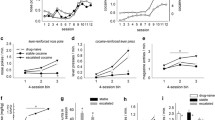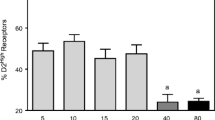Abstract
Previous studies have shown sex different patterns in behavioral responses to cocaine. Here, we used between-subject experiment design to study whether sex differences exist in the development of behavioral sensitization and tolerance to repeated cocaine, as well as the role of protein kinase A (PKA) signaling cascade in this process. Ambulatory and rearing responses were recorded in male and female rats after 1 to 14 days of administration of saline or cocaine (15 mg/kg; ip). Correspondent PKA-associated signaling in the nucleus accumbens (NAc) and caudate-putamen (CPu) was measured at each time point. Our results showed that females exhibited higher cocaine-induced behavioral responses and developed behavioral sensitization and tolerance faster than males. Whereas females developed behavioral sensitization to cocaine after 2 days and tolerance after 14 days, male rats developed sensitization after 5 days. In addition, cocaine induced a sexual dimorphic pattern in the progression of neuronal adaptations on the PKA cascade signaling in region (NAc vs. CPu) and time (days of cocaine administration)-dependent manners. In general, more PKA signaling cascade changes were found in the NAc of males on day 5 and in the CPu of females with repeated cocaine injection. In addition, in females, behavioral activities positively correlated with FosB levels in the NAc and CPu and negatively correlated with Cdk5 and p35 in the CPu, while no correlation was observed in males. Our studies suggest that repeated cocaine administration induced different patterns of behavioral and molecular responses in the PKA cascade in male and female rats.





Similar content being viewed by others
References
Avants SK, Margolin A, Kosten TR, Cooney NL (1995) Differences between responders and nonresponders to cocaine cues in the laboratory. Addict Behav 20:215–224
Back SE, Brady KT, Jackson JL, Salstrom S, Zinzow H (2005) Gender differences in stress reactivity among cocaine-dependent individuals. Psychopharmacology 180:169–176
Badiani A, Browman KE, Robinson TE (1995) Influence of novel versus home environments on sensitization to the psychomotor stimulant effects of cocaine and amphetamine. Brain Res 674:291–298
Becker JB, Hu M (2008) Sex differences in drug abuse. Front Neuroendocrinol 29:36–47
Benavides DR, Quinn JJ, Zhong P, Hawasli AH, DiLeone RJ, Kansy JW, Olausson P, Yan Z, Taylor JR, Bibb JA (2007) Cdk5 modulates cocaine reward, motivation, and striatal neuron excitability. J Neurosci 27:12967–12976
Bibb JA, Chen J, Taylor JR, Svenningsson P, Nishi A, Snyder GL, Yan Z, Sagawa ZK, Ouimet CC, Nairn AC, Nestler EJ, Greengard P (2001) Effects of chronic exposure to cocaine are regulated by the neuronal protein Cdk5. Nature 410:376–380
Brenhouse HC, Stellar JR (2006) c-Fos and deltaFosB expression are differentially altered in distinct subregions of the nucleus accumbens shell in cocaine-sensitized rats. Neuroscience 137:773–780
Carlezon WA Jr, Thome J, Olson VG, Lane-Ladd SB, Brodkin ES, Hiroi N, Duman RS, Neve RL, Nestler EJ (1998) Regulation of cocaine reward by CREB. Science 282:2272–2275
Chen JC, Chen PC, Chiang YC (2009) Molecular mechanisms of psychostimulant addiction. Chang Gung Med J 32:148–154
Elman I, Karlsgodt KH, Gastfriend DR (2001) Gender differences in cocaine craving among non-treatment-seeking individuals with cocaine dependence. The American journal of drug and alcohol abuse 27:193–202
Festa ED, Russo SJ, Gazi FM, Niyomchai T, Kemen LM, Lin SN, Foltz R, Jenab S, Quinones-Jenab V (2004) Sex differences in cocaine-induced behavioral responses, pharmacokinetics, and monoamine levels. Neuropharmacology 46:672–687
Hiroi N, Brown JR, Haile CN, Ye H, Greenberg ME, Nestler EJ (1997) FosB mutant mice: loss of chronic cocaine induction of Fos-related proteins and heightened sensitivity to cocaine’s psychomotor and rewarding effects. Proc Natl Acad Sci U S A 94:10397–10402
Izenwasser S, French D (2002) Tolerance and sensitization to the locomotor-activating effects of cocaine are mediated via independent mechanisms. Pharmacol Biochem Behav 73:877–882
King GR, Joyner C, Lee T, Kuhn C, Ellinwood EH Jr (1992) Intermittent and continuous cocaine administration: residual behavioral states during withdrawal. Pharmacol Biochem Behav 43:243–248
Kosten TA, Gawin FH, Kosten TR, Rounsaville BJ (1993) Gender differences in cocaine use and treatment response. J Subst Abus Treat 10:63–66
Kosten TR, Kosten TA, McDougle CJ, Hameedi FA, McCance EF, Rosen MI, Oliveto AH, Price LH (1996) Gender differences in response to intranasal cocaine administration to humans. Biol Psychiatry 39:147–148
Lobo MK, Zaman S, Damez-Werno DM, Koo JW, Bagot RC, DiNieri JA, Nugent A, Finkel E, Chaudhury D, Chandra R, Riberio E, Rabkin J, Mouzon E, Cachope R, Cheer JF, Han MH, Dietz DM, Self DW, Hurd YL, Vialou V, Nestler EJ (2013) DeltaFosB induction in striatal medium spiny neuron subtypes in response to chronic pharmacological, emotional, and optogenetic stimuli. J Neurosci 33:18381–18395
McClung CA, Nestler EJ (2008) Neuroplasticity mediated by altered gene expression. Neuropsychopharmacology 33:3–17
Miserendino MJ, Nestler EJ (1995) Behavioral sensitization to cocaine: modulation by the cyclic AMP system in the nucleus accumbens. Brain Res 674:299–306
National Survey on Drug Use and Health (2013) U.S. Department of Health and Human Service. http://www.samhsa.gov/data/sites/default/files/NSDUHresultsPDFWHTML2013/Web/NSDUHresults2013.pdf. Accessed 7 Oct 2015
Nazarian A, Sun WL, Zhou L, Kemen LM, Jenab S, Quinones-Jenab V (2009) Sex differences in basal and cocaine-induced alterations in PKA and CREB proteins in the nucleus accumbens. Psychopharmacology 203:641–650
Pliakas AM, Carlson RR, Neve RL, Konradi C, Nestler EJ, Carlezon WA Jr (2001) Altered responsiveness to cocaine and increased immobility in the forced swim test associated with elevated cAMP response element-binding protein expression in nucleus accumbens. J Neurosci 21:7397–7403
Quinones-Jenab V, Jenab S (2010) Progesterone attenuates cocaine-induced responses. Horm Behav 58:22–32
Robbins SJ, Ehrman RN, Childress AR, O’Brien CP (1999) Comparing levels of cocaine cue reactivity in male and female outpatients. Drug Alcohol Depend 53:223–230
Scheggi S, Rauggi R, Nanni G, Tagliamonte A, Gambarana C (2004) Repeated acetyl-l-carnitine administration increases phospho-Thr34 DARPP-32 levels and antagonizes cocaine-induced increase in Cdk5 and phospho-Thr75 DARPP-32 levels in rat striatum. Eur J Neurosci 19:1609–1620
Self DW (2004) Regulation of drug-taking and -seeking behaviors by neuroadaptations in the mesolimbic dopamine system. Neuropharmacology 47(Suppl 1):242–255
Sterling RC, Dean J, Weinstein SP, Murphy J, Gottheil E (2004) Gender differences in cue exposure reactivity and 9-month outcome. J Subst Abus Treat 27:39–44
Van Etten ML, Anthony JC (1999) Comparative epidemiology of initial drug opportunities and transitions to first use: marijuana, cocaine, hallucinogens and heroin. Drug Alcohol Depend 54:117–125
Van Etten ML, Anthony JC (2001) Male-female differences in transitions from first drug opportunity to first use: searching for subgroup variation by age, race, region, and urban status. Journal of women’s health & gender-based medicine 10:797–804
Acknowledgments
We are grateful to Dr. Patricia Stephens for her editorial comments. This work was supported by SCORE 5506-GM60654, MIDARP DA12136, and MD007599RCMI RR-03037. We declare that all the experiments comply with the current laws of the USA.
Author information
Authors and Affiliations
Corresponding author
Ethics declarations
Animal care and use were in accordance with the Guide for the Care and Use of Laboratory Animals (NIH publication 85-23, Bethesda, MD) and approved by the Institutional Animal Care Use Committee of Hunter College of CUNY.
Conflict of interest
The authors declare that they have no conflict of interest.
Additional information
Luyi Zhou and Wei-Lun Sun are equal contributors.
Rights and permissions
About this article
Cite this article
Zhou, L., Sun, WL., Weierstall, K. et al. Sex differences in behavioral and PKA cascade responses to repeated cocaine administration. Psychopharmacology 233, 3527–3536 (2016). https://doi.org/10.1007/s00213-016-4387-6
Received:
Accepted:
Published:
Issue Date:
DOI: https://doi.org/10.1007/s00213-016-4387-6




